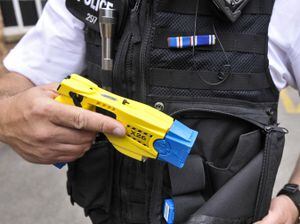Released with a charge – the Taser controversy
It has been 17 years since police forces in England and Wales first trialled Tasers, and the controversy over their use shows no sign of abating.

Since the official roll-out of the technology in 2013, usage has continued to rise year-on-year among forces, to the point where Tasers are now considered a crucial part of an officer’s kit.
Figures released this month for the year to March 2019, show that police deployed stun guns in 23,000 incidents and fired them on 2,500 occasions – up by more than a third on the previous year.
It is safe to say that Boris Johnson’s government is decidedly pro-Taser, with Home Secretary Priti Patel describing the weapon as “an important tactical option when facing potentially physically violent situations”.
This week she has signed off on a £10 million fund to increase the supply of Tasers to police forces, enabling chief constables and police and crime commissioners (PCCs) to bid for the equipment on a new online platform.
“Our brave police officers put themselves in harm’s way to protect us and I am committed to giving them the tools they need to keep themselves and the public safe,” she said.
See also:
“The rise in assaults on officers is appalling, which is why I am providing funding to equip up to 10,000 more officers with Taser.”
Officers from West Midlands Police drew their Tasers 706 times and fired them on 112 occasions, while West Mercia Police discharged Tasers 21 times having drawn them on 331 occasions.
Many senior police figures say there are strong arguments for all frontline officers to be equipped with the weapons.
They point out that assaults on officers have gone up by 50 per cent over the last two years, while it is also claimed that Tasers have been a successful tool when it comes to defusing potentially violent situations.
Police Federation vice-chair Ché Donald, said: “The fact that the figure for instances where the Taser was drawn but not discharged remains so constant reaffirms how effective it can be in de-escalating situations.
“The red dot alone continues to be enough to defuse the vast majority of incidents.”
Protect
West Midlands Police currently has about 1,400 officers who carry Tasers on duty. The force’s PCC, David Jamieson, said the increase would “not only help our dedicated officers keep the public safe, but also ensures that officers can protect themselves.”
He said the government funding may help “offset” some of the costs of his force’s programme, but warned that it would only be successful if it was accompanied by a significant boost in officer numbers.
Deputy Assistant Commissioner Matt Twist, of the National Police Chiefs’ Council, pointed out that force was “rarely used” during officers’ day-to-day duties.
“As the public would expect, most forms of restraint used by officers involve the use of handcuffs in order to arrest an individual,” he said. “It is no surprise that force is often used in cases where the person restrained is drunk or under the influence of drugs, as experience shows these suspects can often be the most difficult and dangerous.”
Last year Northamptonshire Police became the first force in the country to arm all of its frontline officers with the stun guns, followed by Durham Constabulary, which said every frontline officer who wants a Taser will be given one.
A national debate over whether every officer should carry a Taser was ignited after a series of serious attacks on police in August last year.
They included the death of Pc Andrew Harper, who was dragged under a vehicle when he was called to a burglary.
High profile
But campaign groups, including Amnesty International and Liberty, warn against the use of Tasers, pointing out that the equipment has been involved in a number of deaths and injuries.

Arguably the most high profile case involved former Aston Villa player Dalian Atkinson, who died in August 2016 after a Taser was used near his father’s home in Telford. Last year a police officer was charged with murder in connection with the incident.
In 2015 a jury at the inquest of 23-year-old Jordan Begley delivered a narrative verdict concluding that he died partly as a result of being “inappropriately and unreasonably” tasered by Greater Manchester Police officers two years earlier.
According to Amnesty International, 18 people in Britain have died after a stun gun was discharged by police since 2003.
Rosalind Comyn, a policy and campaigns officer at Liberty, said: “Tasers can and do kill. They are deployed disproportionately against people of colour and people experiencing mental health issues, and have alarmingly been used against children under 11.
“Arming every officer will normalise the use of Taser in routine police encounters, which risks escalating, rather than reducing, violence on our streets.”





